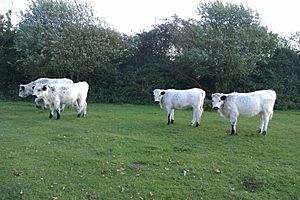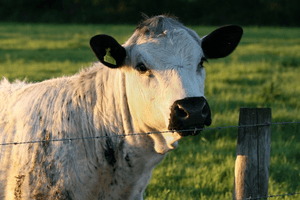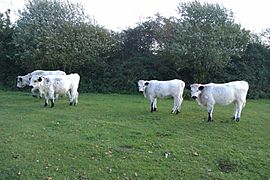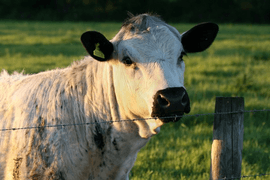Vaynol cattle facts for kids
 |
|
| Conservation status | Critical |
|---|---|
| Country of origin | Great Britain |
| Distribution | Scotland |
| Use | Beef; Leather |
| Traits | |
| Weight |
|
| Coat | White with black points on the ears; black |
| Horn status | Medium upswept horns |
|
|
The Vaynol (pronounced "VAY-nol") is a very rare type of cattle from the United Kingdom. There are fewer than 150 breeding animals left. This makes them one of the rarest cattle breeds in the UK. The Vaynol is currently listed as "critical" by the Rare Breeds Survival Trust. This means they are in great danger of disappearing forever. Today, there are only three official groups of Vaynol cattle in the UK.
The Vaynol is one of three horned cattle breeds that came from ancient white parkland herds in Britain and Ireland. The other two are the Chillingham cattle and the White Park cattle. These old park cattle also led to a fourth similar breed, the British White cattle. This breed does not have horns.
Contents
What Do Vaynol Cattle Look Like?
This endangered breed looks a lot like the White Park cattle. Vaynol cattle have a lean, angular body shape. They have curved back legs and a sloped back end.
Most Vaynol cattle are white with black markings. These black parts are usually on their ears, eyelids, hooves, and nose. Their horn tips can also be black. Sometimes, they even have black "socks" on their legs. Female cows might have black teats on their udders. They have long horns that curve outwards and then upwards.
Male Vaynol cattle, called bulls, usually weigh between 400 and 450 kilograms. Female Vaynol cattle, called cows, weigh about 300 to 350 kilograms.
How Vaynol Cattle Live
Vaynol cattle were once thought to be wild animals. However, because there are so few of them now, they have more contact with people. This means they are now considered "semi-feral." This means they are not fully wild but are not completely tame either.
These cattle do not need a lot of food. This is because they are smaller and lighter than many other cattle breeds. They are known as "upland beef" cattle. This means they are good at living in higher, tougher areas.
Vaynol cattle are also good for something called "conservation grazing." This means they help keep natural areas healthy by eating plants.
- They are a tough and efficient breed. They are great for grazing in many different natural areas.
- Their small to medium size means they are less likely to harm delicate plants or soft ground.
- They grow slowly and mature late. They might need extra food to grow fully within the usual time.
The History of Vaynol Cattle
Vaynol cattle first came from a group of cattle in Wales. The story of this breed goes back over 100 years. It started with a semi-wild group of cattle in 1872. This group lived in a place called Vaynol Park in North Wales.
The cattle stayed there until the owner, Sir Michael Duff, passed away in 1980. After that, the land was sold. The cattle herd then moved to different places in England. This type of cattle has never been very common. The Vaynol cattle we see today are all related to a small number of original animals. In 1989, there was only one group of these cattle left.
Four years later, the Rare Breeds Survival Trust (RBST) bought the herd. They moved the cattle four times to find a permanent home. The original group of Vaynol cattle now lives at Temple Newsam Home Farm. This farm is in West Yorkshire, United Kingdom. It is managed by Leeds City Council.
Temple Newsam Home Farm is open to the public. It has a barn built in 1694. It is the largest working farm in Europe that focuses on rare breeds. It is also the only one of 16 national farms approved by the Rare Breeds Survival Trust. The Trust keeps the official records for Vaynol cattle. They also own most of the breeding animals. The cattle mostly live in large green fields with fences. They are found in big estates and national parks. Like their relatives, the White Park and Chillingham cattle, Vaynol cattle are a reminder of the ancient white cattle that once roamed Great Britain.
In 2009, the Vaynol cattle at Temple Newsam were split into two groups for the first time. Three cows were moved to Lincolnshire, which is about 70 miles away. In 2012, a third group of this breed started with help from The Prince of Wales's Charitable Foundation. This donation helped the RBST buy a young female Vaynol cow named Templeson Ursula. She and her sister Una are cared for by RBST members Derek and Cindy Steen in Scotland.
Why Vaynol Cattle Are Endangered
General Information
Vaynol cattle are one of the rarest cattle breeds in the United Kingdom. There are fewer than 150 breeding animals recorded in the UK.
The Rare Breeds Survival Trust is a charity in the UK. Its goal is to save and protect rare farm animals from disappearing. These cattle are currently on the "critical" list of the Rare Breeds Survival Trust. This means they are very close to extinction.
The Trust is working hard to keep this rare breed alive. They organize care for the existing herds. One important step is to set up special breeding programs. These programs help avoid "inbreeding," which is very dangerous when there are so few animals. Inbreeding means animals that are too closely related have babies. This can lead to unhealthy animals.
Protecting Vaynol Cattle
In 2006, the Rare Breeds Survival Trust and Temple Newsam started a five-year plan to protect the breed. This plan aimed to understand the cattle's genes. This helps to lower inbreeding, which is a key way to protect them. In 2007, the first Vaynol calf was born using artificial insemination. This means a special process where semen from a bull is used to make a cow pregnant. The semen used for this calf was collected from a bull 30 years earlier.
For a long time, breeding Vaynol cattle was only successful at Temple Newsam Home Farm. The methods used at Temple Newsam to save and promote UK livestock have become a model for other groups.
In 2009, a new "satellite herd" was created at East Torrington in Lincolnshire. This was a very important step. It helped to increase the number of Vaynol cattle that can be used for future breeding. This helps secure the breed's future. The Vaynol cattle live on 15 acres of grazing land. This land is owned by Lincoln farmer and RBST Trustees Neville and Maureen Turner. On August 23, 2013, a female calf was born there. Her mother, Templeson Tania, had been artificially inseminated. Now, there are 5 cows and 4 young females, plus this new calf, in the herd in Lincolnshire.
The third herd was started in 2012 with help from The Prince of Wales's Charitable Foundation. This group has 4 cows and 2 young females. They will likely also be part of the artificial insemination program. Having this third herd of Vaynol cattle in Scotland helps spread the breed out. This is important for protecting them if a serious disease breaks out in one area.
Gallery






